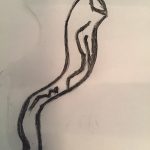By: Marilyn M. Faham
This is an interactive piece to be read by parents and their children together. Read about Sephardic customs of Rosh Hashanah with your children. Have them color in pictures/symbols and talk about the holiday.
On the Seudot, or meals, of Rosh Hashanah we make Berachot, blessings, and eat special foods that are symbols of the holiday, that will bring goodness and blessing into our lives, and direct us to be meritorious in Hashem’s judgement. Some of the foods we eat are pomegranate seeds, apples dipped in honey, a calf’s tongue, Lubia (black eyed peas), dates and more. Before tasting each food, a prayer beginning with the Hebrew words, “Yehi Ratzon”, is said asking Hashem to bless or protect us.

Let’s begin by examining the Rimon (Pomegranate):
The Rimon is one of the Seven Species or Shivat Ha Minim. Inside are hundreds of tiny seeds that remind us of the many Mitzvot we hope to do in the upcoming year. We say: “Be full of mitzvot like the Rimon!” Keep in mind that pomegranates have long been an important symbol in Judaism. Pomegranates decorated the tops of the two columns in the Beit Hamikdash (Temple in Jerusalem) And tiny bells and pomegranates hung from the robe of the Cohen Gadol.
We eat apples dipped in honey and dates that are tasty so we will have a sweet New Year. The tongue of a calf is another delicacy we serve. Why? So, our deeds Will be strong and complete. So, we will be a Rosh or head, and not a Zanav or tail. We strive to be leaders, not followers! We also eat other symbolic foods such as leek and swiss chard so that, Hashem will ward off our enemies and protect us from all who wish to harm us. We also have Lubia (black eyed peas), so our good deeds and merits will be multiplied.
In addition to the Berachot, many Sephardic homes serve a variety of sweets and homemade pastries made with dates, figs, and almonds (such as “Maamool”, “Resab Adweh”) to symbolize our wish that the upcoming year be sweet and joyous. What are some of the other unique customs we experience on Rosh Hashanah? We listen to the kolot of the Shofar. A Shofar is a ram’s horn that reminds us of the Sacrifice of Isaac to Hashem. We listen to the special kolot or sounds of the Shofar to open our hearts to do Teshuva. Teshuva means thinking about what we did wrong and trying to correct ourselves. Unlike animals, man can think and has free will to do Teshuva. We will do better next time!

Our tradition states that Man or Adam Ha Rishon was created on Rosh Hashanah. Hashem created the whole world for man to use for his benefit. Man, for his part, crowns Hashem King and proclaims Him as ruler over us on this day. Rosh Hashanah is also called “The Day of Judgement” because every man is judged for his deeds of the year that passed. Each New Year, everyone’s deeds are weighed on the scales by our Creator. We hope to tip the scales in our favor, so we have more Zechuyot (merits) than Avonot (sins).
On Rosh Hashanah after midday we make Tashlich. We walk to the ocean or stand by a pool of water and say a special prayer “Tashlich”. This prayer is our request to Hashem to throw our sins into the sea and cast them off forever.

Now that Hashem is crowned as our King, man is judged for his deeds and the Ten Days of Repentance begin. During these days we hope to make Teshuva and begin anew.
Shana Tova U’Metuka! Have a Sweet New Year!



